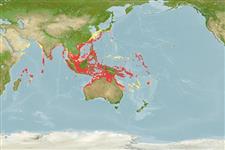>
Eupercaria/misc (Various families in series Eupercaria) >
Lutjanidae (Snappers) > Lutjaninae
Etymology: Lutjanus: Malay, ikan lutjan, name of a fish.
More on authors: Quoy & Gaimard.
Environment: milieu / climate zone / depth range / distribution range
экология
морской; солоноватоводный ассоциированный с рифами; пределы глубины 10 - 72 m (Ref. 9710). Tropical; 35°N - 26°S, 50°E - 180°E (Ref. 55)
Indo-West Pacific: Seychelles, then southern India to New Caledonia and Gilbert Islands, extending northward to the Ryukyu Islands Replaced by Lutjanus ophuysenii from southeastern China and Taiwan to southern Korea and Japan (Ref. 37816).
Length at first maturity / Size / Вес / Возраст
Maturity: Lm 15.4, range 14 - 22 cm
Max length : 40.0 cm TL самец/пол неопределен; (Ref. 55); common length : 35.0 cm TL самец/пол неопределен; (Ref. 5450); наибольший возраст (опубликованны данные): 12 годы (Ref. 37970)
колючие лучи спинного плавника (общее число) : 10; членистые (мягкие) лучи спинного плавника (общее число) : 12 - 14; колючие лучи анального плавника: 3; членистые (мягкие) лучи анального плавника: 8 - 9. Dorsal profile of head moderately sloped. Preorbital width about equal to eye diameter. Preopercular notch and knob poorly developed. Scale rows on back rising obliquely above lateral line. Generally whitish or pink with a yellowish brown to black stripe on the middle of the side. Juveniles and sub-adults with an intensely black mid-lateral stripe and an oval black spot, eye-sized or greater, lying in the middle of the stripe below last dorsal spines. Adults with yellow median fins (Ref. 48635). Body depth 2.6-3.0 in SL (Ref. 90102).
Adults are found in the vicinity of coral reefs, also areas with flat bottoms and occasional low coral outcrops, sponges, and sea whips. They occur singly or in groups of up to about 30 individuals. Feed on fishes, shrimps, crabs and other benthic invertebrates.
Sex ratio differed significantly from 1:1 above 30 cm fork length (Ref. 4840). Larvae grow at a rate of 1.2 to 1.7 mm per day during the first 1 or 2 months.
Allen, G.R., 1985. FAO Species Catalogue. Vol. 6. Snappers of the world. An annotated and illustrated catalogue of lutjanid species known to date. FAO Fish. Synop. 125(6):208 p. Rome: FAO. (Ref. 55)
Статус Красного Списка МСОП (Ref. 130435)
Угроза для людей
Harmless
Использование человеком
рыболовство: коммерческий; аквариум: общественные аквариумы
дополнительная информация
инструменты
Специальные отчеты
Скачать в формате XML
ресурсы в Интернет
Estimates based on models
Preferred temperature (Ref.
123201): 25.1 - 29.1, mean 28.2 °C (based on 1040 cells).
Phylogenetic diversity index (Ref.
82804): PD
50 = 0.5000 [Uniqueness, from 0.5 = low to 2.0 = high].
Bayesian length-weight: a=0.01479 (0.01292 - 0.01693), b=2.97 (2.94 - 3.00), in cm total length, based on LWR estimates for this species (Ref.
93245).
Trophic level (Ref.
69278): 4.0 ±0.3 se; based on diet studies.
Generation time: 3.7 (1.6 - 4.3) years. Estimated as median ln(3)/K based on 10
growth studies.
устойчивость к внешним воздействиям (Ref.
120179): средний (среднего размера), минимальное время удвоения популяции 1.4-4.4 года (K=0.22-0.70; tmax=12).
Fishing Vulnerability (Ref.
59153): Low vulnerability (23 of 100).
Nutrients (Ref.
124155): Calcium = 34.4 [22.4, 47.9] mg/100g; Iron = 0.308 [0.202, 0.482] mg/100g; Protein = 18.7 [17.2, 20.0] %; Omega3 = 0.149 [0.112, 0.200] g/100g; Selenium = 53 [35, 81] μg/100g; VitaminA = 173 [32, 622] μg/100g; Zinc = 0.549 [0.441, 0.738] mg/100g (wet weight); based on
nutrient studies.
